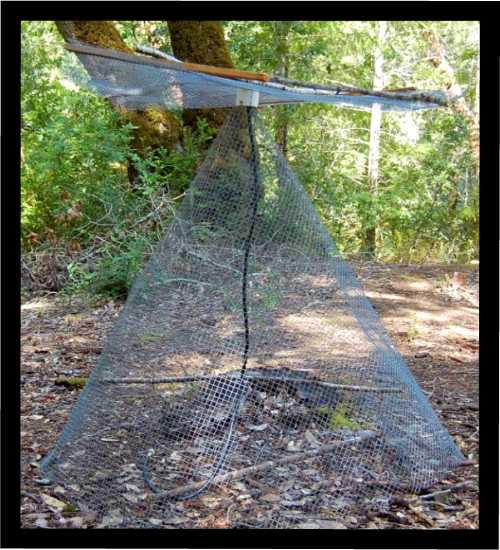The May, 2010 episode of "The SHARC Report" focused on scanners.
We briefly discussed the discone antenna because it works over a broad frequency range without traps or loading coils, and because they're not too difficult to build.
Discone antennas suit the broad frequency requirement of scanners well.
Of course you could buy one of the sleek looking commercially available models for about $100, but how much fun is that ?
I looked around until I found a 4' tall cylindrical hardware-cloth cage once used to protect a plant from deer,
a short length (about 2-1/2") of 2-1/2"d PVC pipe, some short (3"-6") pieces of wire,
a three-foot length of coax with a PL-239 connector on one end, and a few twigs.
I found all of it lying around the house and yard, so this project cost no money.
The discone antenna consists of two elements, a disk and a cone, both made of conductive material, separated by an insulator.
Here's the diagram from the ARRL Antenna Book

Ideally, a scanner antenna should operate from 50Mhz to 500Mhz of higher.
If you do the math you'll see that an L value of 5' would be perfect.
Hardware-cloth however comes on a 4' roll, so for convenience, I built mine with an L value of 4' .
As a result, the Lowest usable frequency for this antenna is 62Mhz,
which cuts off the 10m ham band as well as the CB band, but it still works great on the VHF and UHF bands.
I could add 1' long wires to the edge of the skirt of the cone to pick up those 50-62Mhz signals.
The hardest part of this whole project was forming a 4' cone out of hardware cloth.
After several hours of wrestling with the stuff, I was just glad I hadn't lost an eye.
But looking at the crude, wobbly, and less than symmetrical cone that resulted from my efforts, left me discouraged.
So, I gave up.
A few days later, I looked at it again and decided to just finish the project, for better or worse.
I cut another piece of hardware-cloth into a octagon, figuring that was close enough to a disc for this project.
Then I wired both parts to the piece of PVC pipe that I pre-drilled with 4 equally spaced holes around the circumference, about 1/2 " from each end.
The whole thing drooped and sagged badly, so I reinforced the structure with a few twigs, and wired them in place.
I attached the center conductor of a short length of coax to the center of the disk and the shield braid to the top of the cone.
It was finished.

Using the SHARC club's antenna analyzer, I checked the SWR of this crude discone.
To my amazement, it showed an SWR of less than 2:1 all the way from 68Mhz to 168Mhz, the upper limit of the analyzer.
It works !
So, even though it looks like a crude chicken coop for one lonely chicken, it functions as an effective multi-band radio antenna.
Since the cone connects to ground, this antenna works even when sitting on the ground.
So you could actually use it as a chicken coop, if you wanted to, while using it as an antenna.
However, it will work better if you suspend it with a rope from a tree limb,
or perhaps attach it to your roof, preferably someplace high in the air, and out of sight.
My discone weighs about 10lbs, offers very little wind resistance, and although it is ugly, works well as a VHF-UHF scanner antenna.
It also works great as a transmitting antenna on the 2m and 70cm ham bands.
So there you have it, a chicken coop to replace the rubber duck on your scanner or HT.